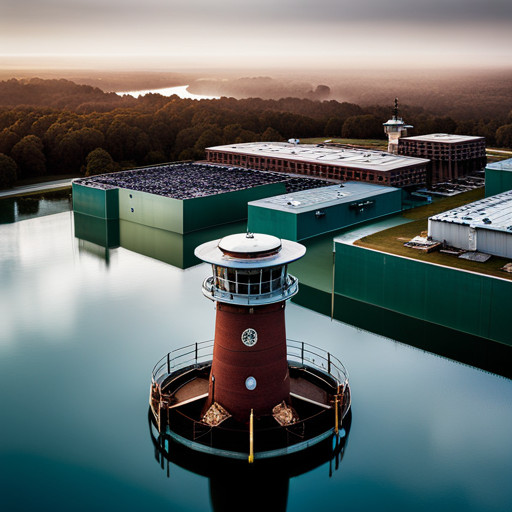Camp Lejeune in Perspective: An Analysis of Military Base Pollutions
This article embarks on a comprehensive analysis of pollution issues at Camp Lejeune, a prominent military base.

Highlighting the historical background, it elucidates the causes and impacts of this environmental concern.
The discussion further extends to the measures taken for mitigation and prospects for future prevention.
The study's objective is to provide detailed insights into these pressing issues, enhancing understanding and facilitating potential solutions.
Key Takeaways
- Camp Lejeune has a long history of pollution due to activities such as weapon testing and poor waste management practices.
- The contamination at Camp Lejeune has led to severe health consequences for personnel and environmental degradation.
- Measures have been taken to mitigate pollution, including stricter legislation, decontamination technologies, and rigorous monitoring systems.
- To prevent future pollution, it is important to enforce strict pollution regulations, conduct regular monitoring and inspections, and promote responsible waste management practices through education and awareness campaigns.
The Historical Background of Camp Lejeune

Established in 1941, Camp Lejeune has a rich historical background that significantly contributes to its current status as one of the most important and largest military bases in the United States. The base establishment was driven by the necessity for an expansive coastal location capable of accommodating amphibious assault training during World War II.
Lejeune's evolution over subsequent decades is marked by remarkable expansion and modernization. By the end of World War II, it hosted more than 200,000 service personnel. The base has since transformed into a hub for advanced military training, supporting operations across numerous global conflicts including Korean War, Vietnam War, Gulf Wars, and Afghanistan conflict.
The base provided cutting-edge facilities including infrastructure such as airfields, state-of-the-art ranges and unique schools focused on specialized combat training. With this growth came increased environmental impact due to various activities like weapon testing and chemical usage - factors that have characterized Lejeune's history of pollution issues.
The narrative of Camp Lejeune's development also reflects larger shifts within military strategy throughout the twentieth century. Its origin as a site for amphibious warfare training embodies an era when naval power was paramount; its eventual diversification reflects how modern armed forces require multifaceted skill sets.
Understanding the Causes of Pollution at Military Bases

Exploring the origins of contamination on such premises reveals a complex interplay of factors, including but not limited to poor waste management practices, use of harmful chemicals in training exercises, and inadequate environmental regulations. The intricate web of causation extends to multiple pollution sources that contribute significantly to the deterioration of environmental health in military bases.
Base industrialization is a primary source of concern as it escalates the potential for pollution through increased operational activities. It encompasses various processes such as fuel combustion, chemical usage, and waste disposal that have adverse impacts on ecological systems. Notably, there has been frequent utilization of harmful chemicals and heavy metals within these bases due to the nature and intensity of their activities.
Waste management inadequacies also emerge as significant contributors towards pollution at military bases. Disposal methods utilized often compromise environmental safety by introducing pollutants into otherwise healthy ecosystems. These contaminants seep into soil layers or water bodies causing extensive harm.
The role played by insufficient regulatory oversight cannot be overlooked in this context either. Often times, robust environmental guidelines are absent or inadequately enforced thus giving room for contamination incidents to occur without sufficient redress mechanisms.
Finally yet importantly is the contribution from past practices which may have left an enduring legacy of pollution despite changes in current operations. For instance, historical usage patterns could have resulted in leaching pollutants over time creating longstanding contamination issues even after cessation.
This multifaceted problem calls for comprehensive interventions that address each contributing factor individually while simultaneously considering their collective impact on overall base healthiness levels.
The Impact of Pollution on Camp Lejeune’s Environment and Personnel

Pervasive contamination issues have significantly affected the ecological health and personnel well-being at a prominent installation, detailing an alarming situation that demands immediate attention. At Camp Lejeune, a military base located in North Carolina, USA, this scenario has been unfolding for several decades. A thorough analysis reveals that harmful substances present in the soil and water bodies have led to environmental degradation along with severe health consequences for its inhabitants.
Regulatory policies enacted by both federal and military authorities failed to prevent or mitigate the damage. Instead of safeguarding the ecosystem and ensuring safe living conditions for personnel and their families, these policies were largely ineffective due to a lack of stringent implementation mechanisms and regular monitoring efforts.
The hazardous chemicals which infested Camp Lejeune's environment primarily included trichloroethylene (TCE), perchloroethylene (PCE), vinyl chloride, benzene among others. These substances are known carcinogens causing numerous health disorders such as leukemia, kidney disease, birth defects etc., posing significant risks to human life.
Research studies further substantiate these claims by showing an elevated incidence rate of cancer among former residents compared to the general population. The analysis also highlights how regulatory policy failures contributed towards turning this military base into one of America's largest environmental disasters.
Measures Taken to Mitigate Pollution at Camp Lejeune

In response to the environmental disaster, a series of significant measures were implemented aiming at mitigating contamination issues and safeguarding health conditions within the installation's premises. Legislation revisions ensued, and stricter pollution legislation was enacted to control further degradation of the environment.
An evaluation of these remediation techniques reveals a combination of conventional and cutting-edge technologies. The application of bioremediation techniques, which utilize microorganisms for breaking down pollutants, marked an innovative approach in decontamination efforts. Coupled with this biological method was the employment of physical-chemical procedures such as soil washing and vacuum extraction to eliminate residual contaminants.
The introduction of stringent pollution legislation also played a pivotal role in shaping remedial actions. New laws necessitated rigorous monitoring systems for potential pollutants, enforced limitations on chemical disposals, and mandated regular inspections. Consequently, institutions found non-compliant faced severe penalties under these revised regulations.
Despite numerous challenges posed by complex contaminant mixtures and expansive contaminated zones, considerable progress has been reported regarding Camp Lejeune's clean-up operations. It is crucial to note that successful pollution mitigation hinges not only on effective remediation but also robust enforcement of pollution legislations.
Analyzing these measures provides critical insights into their effectiveness while highlighting areas requiring more attention for future interventions. It is imperative that continuous reviews be conducted to assess adequacy of adopted strategies against evolving environmental dynamics and technological advancements in contamination management practices.
Exploring Solutions for Future Pollution Prevention at Military Bases

Future prevention of environmental degradation at armed forces installations entails a comprehensive approach that includes the adoption and strict adherence to advanced pollution management strategies. The inclusion of innovative cleanup technologies is vital in this endeavor, as they present effective tools for addressing existing pollution challenges.
Innovative cleanup technologies can provide solutions for complex contamination issues that are often seen at military bases. These technologies, which can include remediation methods such as bioremediation and nanotechnology, work by breaking down contaminants into less harmful substances or completely removing them from the environment. Bioremediation uses naturally occurring microorganisms to degrade pollutants, while nanotechnology employs tiny particles to treat contaminated water or soil. Employing such state-of-the-art techniques not only ensures a more efficient cleanup process but also minimizes further damage to the environment.
Green military operations form an essential part of future preventative measures against environmental degradation at military bases. This concept advocates for the integration of sustainable practices into all aspects of military activities, which could range from using renewable energy sources in barracks to reducing waste during training exercises. By incorporating green practices into their routine operations, military establishments can significantly reduce their ecological footprint.
Frequently Asked Questions
What Are the Health Risks Associated With the Pollution at Camp Lejeune for the Personnel and Local Residents?
Pollution sources at military bases may result in significant health risks for personnel and nearby residents, including cancer, neurological disorders, and birth defects. Remediation techniques are vital to mitigate these potential hazards.
How Does the Pollution at Camp Lejeune Compare to Other Military Bases Around the World?
Comparison of pollution at Camp Lejeune with global military bases reveals similar origins, primarily industrial waste and fuel spills. However, contamination prevention measures vary significantly, affecting the extent of environmental and health impacts.
What Are the Financial Implications of the Pollution Clean-Up Efforts at Camp Lejeune?
The financial implications of pollution clean-up at military bases are substantial, encompassing the identification of pollution sources and implementation of remediation strategies. Costs span from immediate cleanup to long-term health impact mitigation.
How Has the Pollution at Camp Lejeune Affected Local Wildlife and Their Habitats?
The pollution impact at the mentioned location has significantly disrupted local wildlife and their habitats, necessitating extensive wildlife rehabilitation efforts to restore biodiversity and ecological balance in the affected areas.
Are There Any Legal Implications or Lawsuits Related to the Pollution Issues at Camp Lejeune?
Yes, there are legal implications. The legal framework around pollution accountability has resulted in numerous lawsuits relating to health issues allegedly caused by contamination at military bases such as Camp Lejeune.
Conclusion
In conclusion, the pollution issue at Camp Lejeune underscores a broader problem in military bases worldwide. Understanding the causes and impacts of such contamination is key to devising effective mitigation measures.
Although significant steps have been taken to alleviate pollution at Camp Lejeune, comprehensive solutions for future prevention are essential. These findings underline the necessity for system-wide changes in environmental management practices across all military installations.

This post has been generated by AI and was not reviewed by editors. This is Not legal advice. Please consult with an attorney.




